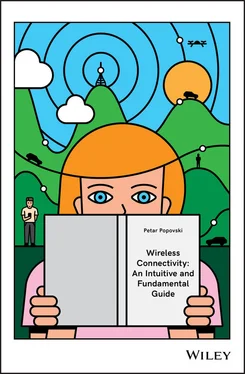 Figure 1.9 Overlapped downlink and uplink frame for a full-duplex base station and devices. H-D is the header for the downlink, H-U for the uplink. The allocation made by H-U is decided based on the reservation slots that occur during H-D. The slots allocated by H-U are slots
Figure 1.9 Overlapped downlink and uplink frame for a full-duplex base station and devices. H-D is the header for the downlink, H-U for the uplink. The allocation made by H-U is decided based on the reservation slots that occur during H-D. The slots allocated by H-U are slots  from the same frame and slot
from the same frame and slot  from the next frame.
from the next frame.
(1.8) 
This is clearly showing that having large data packets,  and
and  , improves the overall efficiency of the system.
, improves the overall efficiency of the system.
One might object to the fact that the number of reservation slots is equal to the number of users  , since the number of users might change. This is not the same as having fixed number of
, since the number of users might change. This is not the same as having fixed number of  data slots in a frame, since Basil can use a scheduling policy to decide how the
data slots in a frame, since Basil can use a scheduling policy to decide how the  slots are used, as informed through the allocation packet A. However, each user should have the opportunity to voice her requirements in a frame; otherwise there should be another, pre-reservation frame to pre-reserve the reservation slots, etc. Expressions (1.6)use a rather conservative estimate of the required resources, as it is always assumed that the number of users is maximal possible. This is clearly inefficient if there are only few active users. A quick fix would be to replace
slots are used, as informed through the allocation packet A. However, each user should have the opportunity to voice her requirements in a frame; otherwise there should be another, pre-reservation frame to pre-reserve the reservation slots, etc. Expressions (1.6)use a rather conservative estimate of the required resources, as it is always assumed that the number of users is maximal possible. This is clearly inefficient if there are only few active users. A quick fix would be to replace  with
with  , the number of currently active users. However, in that case Basil needs to correctly signal this to all active users, along with the allocation of the reservation slots. There can be other ways to make a better use of the reservation slots, based on the partial knowledge that Basil may have about the traffic demands. For example, Basil may use some machine learning methods to estimate which group of users is likely to have data to send in a certain period. We will not go into detail for all possible techniques, as our purpose has been to illustrate only the most important principles. The general class of protocols that addresses the case in which the number of active user is (much) lower than the total number of users is the one of random access protocols , which is the subject of the next chapter.
, the number of currently active users. However, in that case Basil needs to correctly signal this to all active users, along with the allocation of the reservation slots. There can be other ways to make a better use of the reservation slots, based on the partial knowledge that Basil may have about the traffic demands. For example, Basil may use some machine learning methods to estimate which group of users is likely to have data to send in a certain period. We will not go into detail for all possible techniques, as our purpose has been to illustrate only the most important principles. The general class of protocols that addresses the case in which the number of active user is (much) lower than the total number of users is the one of random access protocols , which is the subject of the next chapter.
1.4.4 Half-Duplex versus Full-Duplex in TDMA
Our half-duplex model assumes ideal switching between transmit and receive state, without causing any additional inefficiency in the system. As mentioned before, achieving two-way communication by switching in time between a transmit and a receive state is known as TDD. In practical TDD wireless systems, switching between transmission and reception is not without cost, as it takes a certain turnaround time. Hence, one should avoid having protocols that require from a half-duplex device to switch frequently between transmission and reception. For our discussion, this implies that it is not desirable to have the situation from Figure 1.8(a), where a device needs to switch multiple times from receiving the header, transmitting the reservation packet, receiving the allocation and, potentially, be the first transmitter in the data slots. A possible solution is shown in Figure 1.8(b), where the reservation slot is used to reserve data slot in the next frame or another frame in the future, instead of the current one, thus achieving some form of pipelining.
If the wireless devices have the capability for full-duplex transmission/reception, then there is no need to use TDD and separate the uplink and the downlink frame in time. Figure 1.9shows a possible configuration of a TDMA frame in which the downlink and the uplink transmission take place simultaneously. The gain, usually claimed from full-duplex, is the doubling of the overall data rate or the throughput, as the same communication resource can be simultaneously used twice. This figure illustrates the gain that full duplex brings in terms of latency , which is the time since the packet in a terminal is ready to be transmitted until the time the terminal gets the opportunity to actually transmit it over the air. The header H-U announces the allocation of the uplink slots that follow it, such that the user allocated to slot 1 can start to send immediately after receiving H-U. By contrast, in the previous example of TDD with half-duplex transceivers, the first slot available for transmission is slot 0 in the next frame.
This chapter has dealt with the problem of sharing a single wireless communication channel among multiple communication links. We have used the simplest possible communication model that captures important features of the shared wireless medium, such as broadcast and interference, where the latter is modeled as a collision. We have adopted a packet to be the atomic unit of transmission, meaning that either the whole packet is received correctly or it is completely lost. The objective has been to introduce the main ideas for sharing the channel, such as TDD and TDMA and sketch the elements of a protocol that closely approximates the practical protocols. Where relevant, we have also discussed how the full-duplex capability of the wireless devices can contribute to the design of protocols that are more efficient compared to the case of half-duplex devices.
A classical book that introduces elements of data networking, along with rigorous models is the one by Bertsekas and Gallager [1992]. For rendezvous and link establishment procedures, the reader is referred to the operation of various standards, such as 4G LTE in Dahlman et al. [2013] (chapter 14, Access Procedures), or 802.11 Wi-Fi networks, both in ad hoc and infrastructure mode, see Standards [2016]. Besides Bertsekas and Gallager [1992], another book that offers insights into models for communication over a shared channel as well as stochastic modeling of communication traffic is Rom and Sidi [2012].
1.7 Problems and Reflections
1 State machine for a TDMA system. Describe a possible state machine through which the devices and the base station implement the protocol from Figure 1.7.
2 An even more practical state machine. Extend the state machine from the previous model in order to make the protocol practical, such as introduction of timeout mechanisms, dealing with device mobility, etc.
3 More than one rendezvous channel. Assume that there are different rendezvous channels. Two nodes can establish a link only if one of them sends and the other one receives on the same channel. At a given time, a device can use only one channel. Devise a strategy for establishing a link between two devices and try to compare its performance to the case when there is a single rendezvous channel. When and why would it be useful to have channels for rendezvous?
Читать дальше

 Figure 1.9 Overlapped downlink and uplink frame for a full-duplex base station and devices. H-D is the header for the downlink, H-U for the uplink. The allocation made by H-U is decided based on the reservation slots that occur during H-D. The slots allocated by H-U are slots
Figure 1.9 Overlapped downlink and uplink frame for a full-duplex base station and devices. H-D is the header for the downlink, H-U for the uplink. The allocation made by H-U is decided based on the reservation slots that occur during H-D. The slots allocated by H-U are slots  from the same frame and slot
from the same frame and slot  from the next frame.
from the next frame.
 and
and  , improves the overall efficiency of the system.
, improves the overall efficiency of the system. , since the number of users might change. This is not the same as having fixed number of
, since the number of users might change. This is not the same as having fixed number of  data slots in a frame, since Basil can use a scheduling policy to decide how the
data slots in a frame, since Basil can use a scheduling policy to decide how the  slots are used, as informed through the allocation packet A. However, each user should have the opportunity to voice her requirements in a frame; otherwise there should be another, pre-reservation frame to pre-reserve the reservation slots, etc. Expressions (1.6)use a rather conservative estimate of the required resources, as it is always assumed that the number of users is maximal possible. This is clearly inefficient if there are only few active users. A quick fix would be to replace
slots are used, as informed through the allocation packet A. However, each user should have the opportunity to voice her requirements in a frame; otherwise there should be another, pre-reservation frame to pre-reserve the reservation slots, etc. Expressions (1.6)use a rather conservative estimate of the required resources, as it is always assumed that the number of users is maximal possible. This is clearly inefficient if there are only few active users. A quick fix would be to replace  with
with  , the number of currently active users. However, in that case Basil needs to correctly signal this to all active users, along with the allocation of the reservation slots. There can be other ways to make a better use of the reservation slots, based on the partial knowledge that Basil may have about the traffic demands. For example, Basil may use some machine learning methods to estimate which group of users is likely to have data to send in a certain period. We will not go into detail for all possible techniques, as our purpose has been to illustrate only the most important principles. The general class of protocols that addresses the case in which the number of active user is (much) lower than the total number of users is the one of random access protocols , which is the subject of the next chapter.
, the number of currently active users. However, in that case Basil needs to correctly signal this to all active users, along with the allocation of the reservation slots. There can be other ways to make a better use of the reservation slots, based on the partial knowledge that Basil may have about the traffic demands. For example, Basil may use some machine learning methods to estimate which group of users is likely to have data to send in a certain period. We will not go into detail for all possible techniques, as our purpose has been to illustrate only the most important principles. The general class of protocols that addresses the case in which the number of active user is (much) lower than the total number of users is the one of random access protocols , which is the subject of the next chapter.










